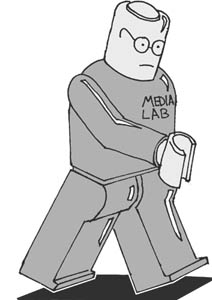![[Metroactive Features]](http://metroactive.com/features/gifs/feat468.gif)
[ Features Index | Silicon Valley | Metroactive Home | Archives ]
By Annalee Newitz
HAVING BILLED myself as a "media nerd" for so long, I suppose it was inevitable that I'd find myself in the only lab I've ever heard of whose principle area of investigation is simply "media." I'm talking about MIT's mysterious Media Lab, whose researchers are responsible for bringing things like holograms, virtual Lego games and wearable computers to the masses.
For about a decade after its founding in 1985, the Media Lab was synonymous with terms like "bleeding-edge" and "killer app." Secret, swollen with funding and immensely influential, the Media Lab's playful, artistic approach to technology was truly the avant-garde. It was the "new" in new media. Today, however, the Media Lab's mystique is gone. It's not that the lab has changed--rather, high-tech culture has become so similar to the Media Lab that what was once a cutting-edge enterprise is now simply an intensified version of mainstream culture.
First-generation Media Laboids transformed the academic injunction "publish or perish" into the almost hysterically productive "demo or die," but current Media Lab director Walter Bender would prefer to describe the lab's mantra as "imagine and realize." When I met him, he had just come out of a meeting with Hallmark execs. They wanted to brainstorm with Laboids about new ideas for Christmas ornaments. Bender's group suggested various ways to make ornaments that respond to sounds in their environment. Hallmark was apparently pretty excited.
Even if the lab is sometimes as middle-of-the-road as a Hallmark card, the spirit of demo or die lives on. Even the most imaginative and random notions can be converted into Media Lab projects (and demos): 3D copy machines, a robotic DJ (yes, you can dance to its beats), soy sauce bottlebased computer interfaces. When I strolled through several floors of the lab--whose dominant interior design features are glass walls, brightly colored furniture and fanciful tech objects in a wide array of sizes--I felt like I was immersed in a particularly psychedelic Wired design layout.
After giving us a tour, director Bender hurried off to play Legos with some students. Largely because of longtime laboid Mitchel Resnick's supersuccessful LEGO Mindstorms, the little plastic bricks are like a religion at the lab. They symbolize all its deepest-held institutional beliefs: that childlike creativity is good, that fun is useful and that every idea needs a demo, even if it's only a toy.
The Media Lab's main goal is obviously to create the working environment that early-'90s corporate guru Tom Peters called "WOW!" Both the lab's aesthetics (rooms full of Legos!) and guiding principles (Have fun!) reminded me of a fantastic dotcom during the boom years, albeit without the free food and soda. Undergraduates in the quantum-computing lab were dancing and air-guitaring on their keyboards next to a gigantic tank labeled NITROGEN. One lone brainiac named Erik Blankenship in the Critical Computing lab gave us a demo of his latest creation: a computer program that searches through four seasons of Star Trek for specific lines of dialogue so that fans can communicate using phrases spoken by their favorite characters. "Say, for example, you wanted to say hello to someone," Erik enthused. "Well, you could look for a scene where Spock says hello and then use that clip to greet your friends!" Watch for Erik's demos at an SF con near you.
Despite being utterly seduced by many of the lab's projects--I want a wearable computer like any self-respecting geek would--I never felt like I was seeing something revolutionary. Instead, I was seeing the culture I'd grown up with: the frenetic, gorgeous, media-rich, body-modification, digital-everything technoculture of the late-20th-century United States. Machines that shoot sound and programs that build in cyberspace are the common dreams of my entire generation. The Media Lab has lived to see its own cultural domination, and as that's happened a curious change is coming over the lab itself.
It's becoming more open.
Part of this openness is a result of a new program that brings hundreds of undergraduates to work in the lab. But perhaps the most surprising aspect of the Media Lab's openness is its unique funding model, which has made it perhaps the most overtly industry-driven think tank on the MIT campus. Companies (and, occasionally, government agencies) buy various levels of lab sponsorship, starting at $100,000 per year. These sponsorships give companies the right to use any of the technology in development at the lab for free, which is a pretty sweet deal as long as the demos work and aren't designed to "subvert broadcast media." While it may be a Faustian bargain these Lego freaks have struck, at least they don't hide their funding sources. Nor do they pretend to be anything other than corporate-sponsored. Laboids make demos, not theories. Now only one question remains: What comes after Media Lab culture?
[ Silicon Valley | Metroactive Home | Archives ]
Copyright © Metro Publishing Inc. Metroactive is affiliated with the Boulevards Network.
For more information about the San Jose/Silicon Valley area, visit sanjose.com.
![]()

The Lego Mystique
Annalee Newitz ([email protected]) is a surly media nerd who has no lab.
Send a letter to the editor about this story to letters@metronews.com.
From the November 7-13, 2002 issue of Metro, Silicon Valley's Weekly Newspaper.